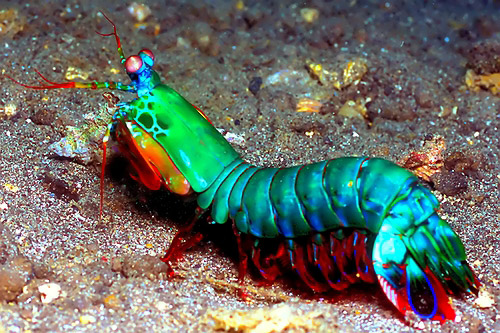Bet you didn't know this! (Facts)
First and foremost, you should know that this
species does not only go by its scientific name, Pseudosquilla
ciliata. This species goes by many common names; One of these
common names being False shrimp, this name is actually the English
translation of the species genus and specific epithet (Campbell, 2012). A
second name this interesting species goes by is Rainbow shirimp
(Campbell, 2012)
Journee and I were fortunate to find out, after researching a bit, why this species took on the name Rainbow shrimp. P.ciliata takes this name on because of its incredible ability to blend in with the surfaces it lives on (Campbell, 2012). It is able to do this because of the multiple colors it possesses. This species can blend in with almost all surfaces it inhabits. Sometimes it’s even possible for Pseudosquillia ciliata to conform or completely camouflage with the surfaces they are on; this takes many weeks and many rounds of ecdysis - molting (Stacey et al, 2002). P.ciliata can take on body colors including yellow, black, brown, green and more (Campbell, 2012)!
Because
P.ciliata are able to camouflage with the surfaces they are on,
this species
inhabits burrows within dead coral; they hide and sleep in these burrows
during the night, but actively wait for prey to swim by during the day
(Campbell, 2012). These burrows are found to be very
useful for capturing prey (Campbell, 2012). P.ciliata are known to be one of the
fastest organisms inhibiting the ocean’s shallow waters giving them a
huge advantage over their prey (Campbell, 2012). It has been
found that P.ciliata
can strike at speeds up to 30 mph (Campbell, 2012).
Without reproduction though these organisms
would not be found. An interesting article by
Marea E. Hatziolos and Roy L. Caldwell
explains the interesting ways P.ciliata reproduce. While reading
the article I found it hard to
grasp the fact that in an odd way we, as humans, use some of the same
tactics that this species does to attract those they want to mate with. P.ciliata
use many different techniques to attract their mates (Hatziolos, 1983).
First off, you should know that this is the first known form of role
reversal in mantis shrimp (Hatziolos, 1983). This type of role reversal
is very uncommon and only found in certain species. What is role
reversal? Role reversal is where the females of a certain species try their hardest to impress the
males. Females do this by using many different techniques
(Hatziolos, 1983). These techniques to impress the male usually happen in a certain
pattern and can take up to twenty minutes or longer (Hatziolos, 1983).
Wow, after hearing all of these interesting
facts you must be thinking it would be awesome to keep one of these
organisms as a pet right? Well you can! I found that not many stores
sell P.ciliata, but few do. Click this link to go to the pet
place if you are interested buying one today
http://www.thatpetplace.com/mantis-shrimp-pseudosquilla-ciliata-261568
. Warning though, because of their strong appendages, P. ciliata
are known to break through glass tanks even if the glass is double layered. They are also a bit pricey, but they are definitely worth
it!
Click to continue to the
Gallery!
Or click to return to Home!
